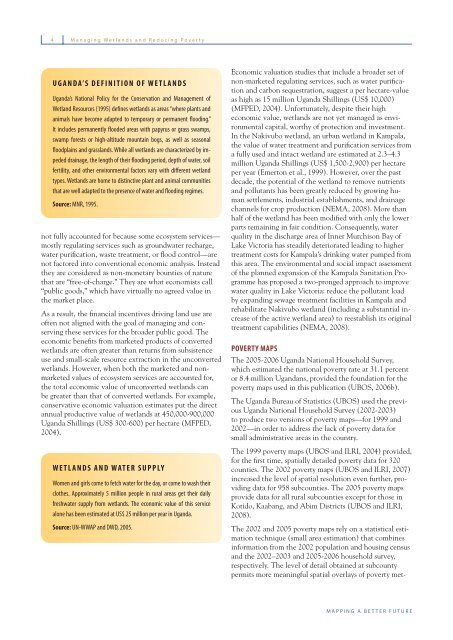Mapping a Better Future - World Resources Institute
Mapping a Better Future - World Resources Institute
Mapping a Better Future - World Resources Institute
You also want an ePaper? Increase the reach of your titles
YUMPU automatically turns print PDFs into web optimized ePapers that Google loves.
4 Managing Wetlands and Reducing Poverty<br />
UGANDA’S DEFINITION OF WETLANDS<br />
Uganda’s National Policy for the Conservation and Management of<br />
Wetland <strong>Resources</strong> (1995) defines wetlands as areas “where plants and<br />
animals have become adapted to temporary or permanent flooding.”<br />
It includes permanently flooded areas with papyrus or grass swamps,<br />
swamp forests or high-altitude mountain bogs, as well as seasonal<br />
floodplains and grasslands. While all wetlands are characterized by impeded<br />
drainage, the length of their flooding period, depth of water, soil<br />
fertility, and other environmental factors vary with different wetland<br />
types. Wetlands are home to distinctive plant and animal communities<br />
that are well adapted to the presence of water and flooding regimes.<br />
Source: MNR, 1995.<br />
not fully accounted for because some ecosystem services—<br />
mostly regulating services such as groundwater recharge,<br />
water purifi cation, waste treatment, or fl ood control—are<br />
not factored into conventional economic analysis. Instead<br />
they are considered as non-monetary bounties of nature<br />
that are “free-of-charge.” They are what economists call<br />
“public goods,” which have virtually no agreed value in<br />
the market place.<br />
As a result, the fi nancial incentives driving land use are<br />
often not aligned with the goal of managing and conserving<br />
these services for the broader public good. The<br />
economic benefi ts from marketed products of converted<br />
wetlands are often greater than returns from subsistence<br />
use and small-scale resource extraction in the unconverted<br />
wetlands. However, when both the marketed and nonmarketed<br />
values of ecosystem services are accounted for,<br />
the total economic value of unconverted wetlands can<br />
be greater than that of converted wetlands. For example,<br />
conservative economic valuation estimates put the direct<br />
annual productive value of wetlands at 450,000-900,000<br />
Uganda Shillings (US$ 300-600) per hectare (MFPED,<br />
2004).<br />
WETLANDS AND WATER SUPPLY<br />
Women and girls come to fetch water for the day, or come to wash their<br />
clothes. Approximately 5 million people in rural areas get their daily<br />
freshwater supply from wetlands. The economic value of this service<br />
alone has been estimated at US$ 25 million per year in Uganda.<br />
Source: UN-WWAP and DWD, 2005.<br />
Economic valuation studies that include a broader set of<br />
non-marketed regulating services, such as water purifi cation<br />
and carbon sequestration, suggest a per hectare-value<br />
as high as 15 million Uganda Shillings (US$ 10,000)<br />
(MFPED, 2004). Unfortunately, despite their high<br />
economic value, wetlands are not yet managed as environmental<br />
capital, worthy of protection and investment.<br />
In the Nakivubo wetland, an urban wetland in Kampala,<br />
the value of water treatment and purifi cation services from<br />
a fully used and intact wetland are estimated at 2.3–4.3<br />
million Uganda Shillings (US$ 1,500-2,900) per hectare<br />
per year (Emerton et al., 1999). However, over the past<br />
decade, the potential of the wetland to remove nutrients<br />
and pollutants has been greatly reduced by growing human<br />
settlements, industrial establishments, and drainage<br />
channels for crop production (NEMA, 2008). More than<br />
half of the wetland has been modifi ed with only the lower<br />
parts remaining in fair condition. Consequently, water<br />
quality in the discharge area of Inner Murchison Bay of<br />
Lake Victoria has steadily deteriorated leading to higher<br />
treatment costs for Kampala’s drinking water pumped from<br />
this area. The environmental and social impact assessment<br />
of the planned expansion of the Kampala Sanitation Programme<br />
has proposed a two-pronged approach to improve<br />
water quality in Lake Victoria: reduce the pollutant load<br />
by expanding sewage treatment facilities in Kampala and<br />
rehabilitate Nakivubo wetland (including a substantial increase<br />
of the active wetland area) to reestablish its original<br />
treatment capabilities (NEMA, 2008).<br />
POVERTY MAPS<br />
The 2005-2006 Uganda National Household Survey,<br />
which estimated the national poverty rate at 31.1 percent<br />
or 8.4 million Ugandans, provided the foundation for the<br />
poverty maps used in this publication (UBOS, 2006b).<br />
The Uganda Bureau of Statistics (UBOS) used the previous<br />
Uganda National Household Survey (2002-2003)<br />
to produce two versions of poverty maps—for 1999 and<br />
2002—in order to address the lack of poverty data for<br />
small administrative areas in the country.<br />
The 1999 poverty maps (UBOS and ILRI, 2004) provided,<br />
for the fi rst time, spatially detailed poverty data for 320<br />
counties. The 2002 poverty maps (UBOS and ILRI, 2007)<br />
increased the level of spatial resolution even further, providing<br />
data for 958 subcounties. The 2005 poverty maps<br />
provide data for all rural subcounties except for those in<br />
Kotido, Kaabang, and Abim Districts (UBOS and ILRI,<br />
2008).<br />
The 2002 and 2005 poverty maps rely on a statistical estimation<br />
technique (small area estimation) that combines<br />
information from the 2002 population and housing census<br />
and the 2002–2003 and 2005-2006 household survey,<br />
respectively. The level of detail obtained at subcounty<br />
permits more meaningful spatial overlays of poverty met-<br />
MAPPING A BETTER FUTURE

















